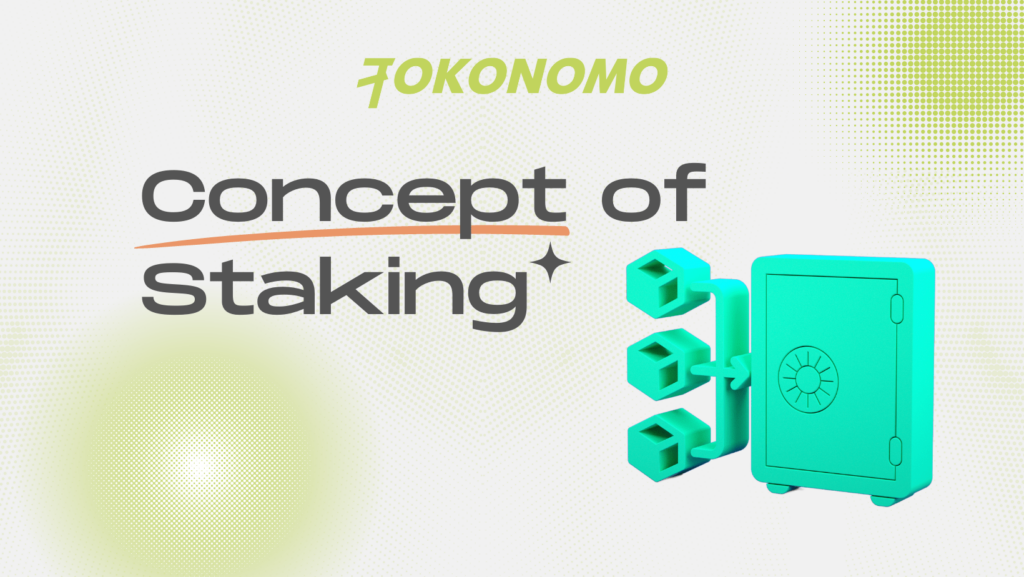Table of Contents
- What is Staking?
- What is the concept of staking?
- What is Proof of Stake (PoS)? Proof of Stake (PoS) and Proof of Work differences (PoW)
- How to stake your cryptocurrencies?
- How much money can you make staking crypto?
- Is it worth staking your crypto?
- Can you lose money staking crypto?
- Best coins/tokens to stake in 2023
- What are dividend tokens?
- Conclusion
Selling your investment at a profit as the market price rises is one way to earn from cryptocurrencies.
Staking is one of the additional ways to profit from cryptocurrencies. You may use staking to put your digital assets to work and generate passive revenue without having to sell them.
What is Staking?
Staking is a method of collecting interest on your cryptocurrency by storing it for a predetermined amount of time. Staking functions similarly to interest-bearing accounts with conventional banks.
What is the concept of staking?


If you own a cryptocurrency that runs on a proof-of-stake blockchain, you are allowed to stake your tokens.
Stake your assets in order to participate and help maintain the blockchain’s security for that network. Staking incentives are rewards that validators earn in that coin in exchange for locking up their assets and participating in network validation.
The staking process is similar to how savings accounts work. Traditional banks impose interest because they use your funds for loans, investments, and other purposes. Your cryptocurrency is used in staking as well. Staking is a term used to describe the Proof of Stake, or “PoS,” protocol, which uses staked currencies to verify blockchain transactions. Staking is a component of the consensus procedures used by the well-known cryptocurrencies Ethereum (ETH) and Solana (SOL).
What is Proof of Stake (PoS)? Proof of Stake (PoS) and Proof of Work differences (PoW)
A cryptocurrency consensus mechanism called proof-of-stake is used to process transactions and add new blocks to a blockchain.
Proof of work, the first cryptocurrency consensus mechanism created, is a substitute for this process.
Blockchains are able to conduct transactions, validate data, and synchronize data thanks to both consensus mechanisms. Both techniques have successfully maintained blockchains, but the two algorithms take quite different ways to do so.
Block creators are known as validators in a PoS system. A validator examines transactions, confirms activity, casts votes on results, and keeps records. Block creators are referred to as miners in PoW. To validate transactions, miners try to get the hash, a cryptographic integer. They receive a coin as payment for cracking the hash.
You simply need to have enough coins or tokens to qualify as a validator on a PoS blockchain in order to “purchase into” the role of a block maker. For PoW, miners must make significant investments in processing hardware and pay high energy costs to power the machines running the computations. As concern has grown about how crypto mining impacts the environment, proof of stake has grown in popularity because it is far more energy-efficient.
How to stake your cryptocurrencies?


There are two ways to stake, but one involves much more effort than the other.
- The first approach entails creating and managing your own node. This takes some familiarity with and proficiency with staking as well as the coin you’ve chosen to stake. To become a “complete validator,” you must also achieve the staking minimum. For example, Ethereum requires a minimum of 32 ETH (at the time of writing) to stake before becoming a validator.
- Using an exchange or other cryptocurrency platform to stake is the second (and simplest) way. This method only requires you to deposit your coins and consent to stake them. Many leading crypto exchanges like Coinbase, Binance, and FTX offer safe and easy ways to stake your crypto. Also staking options might be available in the DeFi wallet you chose to save your crypto. Usually staking options are provided there by different decentralized platforms.
How much money can you make staking crypto?
You will be informed of the staking rewards offered by a program when you choose it.
Different DeFi platforms or cryptocurrency exchanges provide different annual percentage yields (APY). The numbers could vary from as low as 0,5% to as much as 15% or more. It all depends on the chosen staking provider and a chosen cryptocurrency.
For example, Ethereum offers a 4% to 7% annual percentage yield (APY) for staking.
Once you’ve decided to stake cryptocurrency, you’ll get the promised return when it’s due. You will receive your return from the program in the staked cryptocurrency, which you may then hold as an investment, offer for staking, or exchange for cash and other cryptocurrencies.
The scheme may also be subject to limitations, such as a three-month staking commitment before receiving your tokens back. Make sure to use a staking calculator before staking your selected tokens. It will help you to calculate the amount of cryptocurrency you will get within the selected timeframe.
Is it worth staking your crypto?
Staking is an excellent choice for investors who don’t care about short-term price volatility but are concerned in earning returns on their long-term investments. Avoid locking up money for staking if you might need it back quickly before the staking time is up.
To determine how long the staking period will last and how long it will take to get your money back when you decide to withdraw, you need carefully understand its terms.
Can you lose money staking crypto?
Staking involves some risk.
Depending on the scheme, you might be required to stake your tokens for a period of weeks or months. You wouldn’t be able to pay out or trade your tokens at this time. Also being exceedingly risky investments, cryptocurrencies frequently see double-digit price fluctuations during market crashes. You wouldn’t be able to sell your cryptocurrency during a slump if you were staking it in a program that locked you in. The staking platform you select might provide significant annual returns, but you still run the risk of losing money if the value of the staked token declines.
Best coins/tokens to stake in 2023


By involving some risks in the staking process, it is important to stake coins/tokens that will have the lowest risks of a plummet in price. This will ensure a better and safer experience for you.
So, when choosing a coin/token to stake you should consider a few things like market cap, reputability of the project, and real-time application. Another thing to keep in mind when picking the best coins to bet is to have faith that it’s a long-term investment. So, if you think a certain blockchain network has worth, the daily fluctuations could not have an impact on your willingness to sell. Therefore, be certain that you support the project and mission before seeking for coins to stake.
Our list of the best coins/tokens to stake consists of the most reputable and popular cryptocurrencies nowadays.
It consists of coins like Ethereum (ETH), Solana (SOL), Binance Coin (BNB), Tether (USDT), USD Coin (USDC), and Cardano (ADA). All of these cryptocurrencies proved their reputability and are supposed to have good long-term potential considering different important factors.
What are dividend tokens?
A dividend is a payment made to a group of a company’s shareholders from a percentage of its earnings. Therefore, a dividend token is one that distributes earnings to its investor in the form of dividends.
Dividend tokens are created to give their owners the chance to invest in a certain project and earn passive income while also benefiting from any potential value growth.
These tokens provide access to the issuing company’s profits. Additionally, some blockchains’ native currencies are similar to being categorized as dividend tokens because they come with dividend-like features by default. Similar to stocks, dividend token features may or may not grant voting rights.
Unlike stocks, holding dividend tokens entitles the bearer to passive income without having to be an owner or actively participate in the parent company’s daily activities.
The dividend token idea serves as the foundation for the staking concept described earlier. Although it may depend on the level of token ownership, dividend payments are normally issued on a weekly or monthly basis.
Conclusion
Both those active in the cryptocurrency realm and those outside of it can benefit greatly from the staking process.
Stakers can benefit from interest payments on their bitcoin investments, potentially raise the value of their holdings, and support a vibrant cryptocurrency ecosystem.
Staking is also more environmentally friendly. It cuts down on energy use, carbon emissions, and electronic trash. That sounds like a pretty huge thing when you consider that the present carbon footprint of Bitcoin is similar to that of the whole nation of Oman. Staking is thereby effective, profitable, and environmentally friendly.











